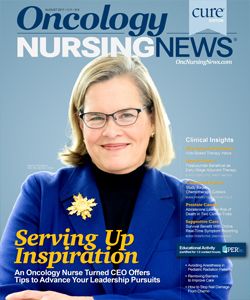Removing Barriers to Improve Care
Nurse navigators at Sarah Cannon use oncology pathways to help ensure patient access to seamless care across the cancer continuum.
Crystal Dugger, MBA, MSN, RN
Crystal Dugger, MBA, MSN, RN

For patients with cancer, moving through the phases of diagnosis, treatment, and survivorship can be more than a little daunting. The process can seem like a different world, with a whole new language. Personalized treatments, molecular profiling, and immunotherapies have led to advances in treatment, but they also add a layer of complexity at a time when patients and their loved ones are feeling terrified and overwhelmed.
Enter the nurse navigator, a certified RN with navigation training tailored to a specific type of cancer. The nurse navigator’s role is to empower patients and families by eliminating barriers to care, providing education about their specific cancer, available treatments and clinical trials, as well informing them how to find support, such as physical and psychosocial therapy and financial and transportation resources.
Sarah Cannon, the Cancer Institute of HCA Healthcare, has built a flagship navigation program to serve its cancer programs across the nation. The program has seen tremendous growth—from just 5 nurse navigators in 2011 to 200 today. The number one goal of the navigation program, explained Crystal Dugger, MBA, MSN, RN, assistant vice president of clinical operations at Sarah Cannon, “is to help patients stay compliant with the treatment plan.”
“Nurse navigators are the point person for the patient throughout the entire continuum of care,” she continued. And, nurse navigators are not there just for the patients. At Sarah Cannon, navigators also coordinate office visits, streamline communication among other members of the healthcare team, and organize multidisciplinary team conferences. With a process that has as many moving parts as cancer care, the nurse navigator can function as a conductor, ensuring that all departments know how to work with one another in the most efficient and effective way.
“Nurse navigators are the point person for the patient throughout the entire continuum of care.”
The impact of the program can be seen in many ways, but especially in the patient experience. As just 1 example, Dugger mentioned a patient who had been diagnosed with breast cancer 8 years ago, before the navigation program was in place. Recently, that same patient had a recurrence and was given a nurse navigator. “She could not stop talking about the difference in the experience that she had from the first time compared to the second time,” Dugger said.
Oncology Pathway for Navigation
Dugger attributes much of the success of Sarah Cannon’s navigation program to the creation of oncology pathways— guided by physicians and based on tumor type and stage—that help ensure seamless care across the cancer journey for both patients and providers. These pathways help to standardize the training and role of the nurse navigator, with an eye toward achieving critical quality metrics and optimal patient outcomes throughout the health system.
The Sarah Cannon program assigns a nurse navigator to the patient at the time of diagnosis. In turn, the navigator walks with the patient through every step of the cancer journey: diagnosis, genetic testing, treatment, palliative, and/or supportive care.
Nurse navigators at Sarah Cannon also keep the patient’s own specific goals in mind. “The navigator’s job is to ensure that the voice [of the patient] is heard in our multidisciplinary conferences, when providers are creating the treatment options for the patient.” Dugger recalled a patient who was a concert pianist, but the standard chemotherapy was likely to cause neuropathy, or severe numbness in the fingertips, a side effect that would have a tremendously negative impact on that patient’s livelihood. Survival statistics were not quite as good with another chemotherapy option, but that therapy offered a lower neuropathy risk, an option the patient preferred. Without the nurse navigator advocating on the patient’s behalf, this risk may have been missed.
Building a Success Program
For other institutions seeking to start or improve their own navigation programs, Dugger urges starting with a vision: “What are you trying to accomplish? What is the goal you’re trying to reach?” It is also necessary to have other programs and departments fully on board: “You need to make sure you have physician and administrative alignment.”
Successful navigation programs ultimately depend on a workable business model. “We have to make sure that we’re being impactful within the budget,” Dugger stressed. For Sarah Cannon, this meant measuring patient satisfaction and retention at the facility. Although nurses can sometimes be uneasy focusing on financial aspects, they’re important for creating a sustainable program.
To facilitate demonstration of the navigation program’s value, Sarah Cannon’s proprietary iNavigate data collection software captures key metrics such as timeliness to first treatment, patient satisfaction, and navigator retention, which generates a scorecard that captures all data into one report.
“At the end of the day, our goal is to help more patients. You’re going to do that by showing a good business model, so you can get resources, grow your program, and show improvement.”
For nurses who are unfamiliar with quality and financial metrics or may be uncomfortable with this line of thinking, Dugger urges them to get more involved with leadership. “Nurses have to start talking from the perspective of both sides of the business. We have to get nurses thinking that way,” she said.

COVID-19 Pandemic Emphasizes Disparities in Cancer Care
September 17th 2021“We’ve had periods of time where things were shut down. We do have telemedicine, that was expanded, but telemedicine doesn’t work for everyone. If you don’t have internet access, if you don’t have the ability to understand the technology….”



